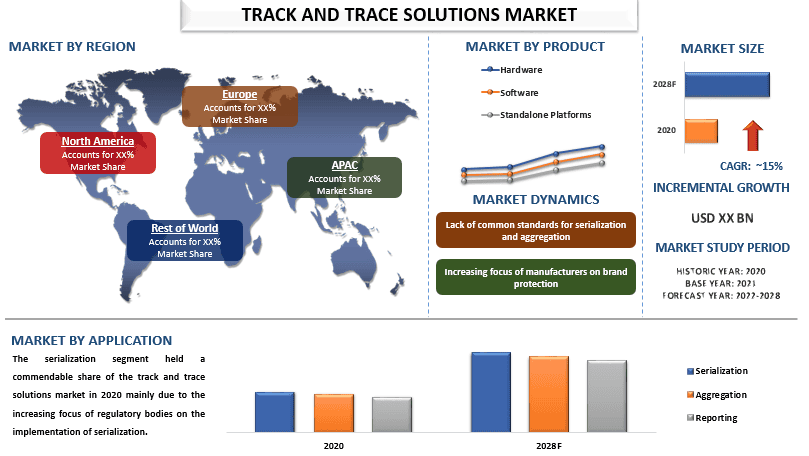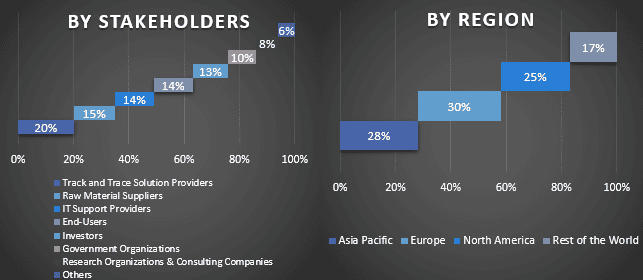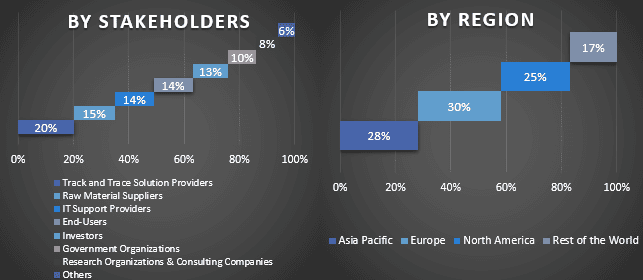Emphasis on Product (Hardware, Software, and Standalone Platforms); Technology (2D Barcode and RFID); Application (Serialization, Aggregation, and Reporting); End-Use Industry (Pharmaceuticals, Food and Beverages, Consumer Packaged Goods, Luxury Goods, and Others); and Region/Country

The global Track and Trace Solutions Market is expected to grow at a growth rate of around 15% during the forecast period. Track and trace in healthcare allow for identifying the current and past location of each item in the supply chain. This is an essential and powerful tool for pharmaceutical companies. Especially as regulations mandate traceability and specific requirements for recording and sharing supply chain data. Manufacturers of biopharmaceuticals, pharmaceuticals, cosmetics, and medical devices deploy track-and-trace solutions to protect their products and brand equity. Moreover, the rising counterfeiting and theft of healthcare products are on the rise around the globe which is a prominent factor driving the growth of the market. For instance, according to the World Custom Organization (WCO), in 2020, the annual revenue of the drug counterfeiting market reached USD 200 Bn, and it is 20 times more profitable than trafficking heroin. Further, suitable regulations on serialization implementations are also influencing the adoption of track and trace solutions in the healthcare industry. For instance, it is mandatory for pharmaceutical manufacturers to serialize all prescription drugs at the unit of sale level compliant with requirements set out in the Falsified Medicines Directive 2011/62/EU.
Some of the major players operating in the market include Systech International, OPTEL GROUP, TraceLink Inc., ANTARES VISION S.p.A., Siemens AG, Körber AG, ACG Group, Robert Bosch GmbH, Zebra Technologies Corporation, and Uhlmann Pac-Systeme Several M&As along with partnerships have been undertaken by these players to facilitate customers with hi-tech and innovative products/technologies.
Insights Presented in the Report
“Amongst product, software segment to witness robust CAGR during the forecast period”
Based on product, the market is segmented into hardware, software, and standalone platforms. The software segment catered to a significant share of the track and trace solutions market in 2020. This is majorly due to the growing adoption of software in healthcare, pharmaceuticals, biopharmaceuticals, and medical device companies. These software solutions are used for the continuous management of production facilities, product lines, case and bundle tracking, warehousing, and shipping.
“Amongst Technology, 2D barcode segment to hold a significant share in the market in 2020”
Based on technology, the market is bifurcated into 2D barcode and RFID. The 2D barcode technology segment is expected to grow at a strong CAGR during the forecast period. The increasing use of 2D barcodes in pharmaceutical and biopharmaceutical packaging is a key factor contributing to the growth of the market. Additionally, 2D barcodes offer greater data storage capacity compared to linear barcodes and are more popular in the industry, hence the demand for 2D barcode-based solutions is increasing.
“North America captured a significant share of the market in 2020”
North America captured the highest share of the market in 2020. North America’s large share can be attributed to the presence of a large number of pharmaceutical and biotech companies, the high regulatory burden to implement serialization and aggregation solutions, and the growing medical device industry. Pharmaceutical serialization requirements apply to pharmaceutical companies, repackagers, wholesalers, and dispensers in the United States. Additionally, the presence of sophisticated medical infrastructure and the adoption of this technology in the United States is expected to drive the market.
Reasons to buy this report:
Customization Options:
The global track and trace solutions market can further be customized as per the requirement or any other market segment. Besides this, UMI understands that you may have your own business needs, hence feel free to connect with us to get a report that completely suits your requirements.
1. Market Introduction
2. Research Methodology Or Assumption
3. Market Synopsis
4. Executive Summary
5. Global Track And Trace Solutions Market Covid-19 Impact
6. Global Track And Trace Solutions Market Revenue, 2020-2028f
7. Market Insights By Product
8. Market Insights By Technology
9. Market Insights By Application
10. Market Insights By End-use Industry
11. Market Insights By Region
12. Track And Trace Solutions Market Dynamics
13. Track And Trace Solutions Market Opportunities
14. Track And Trace Solutions Market Trends
15. Demand And Supply-side Analysis
16. Value Chain Analysis
17. Competitive Scenario
18. Company Profiled
19. Disclaimer
Research Methodology for the Track and Trace Solutions Market Analysis (2022-2028)
Analyzing the historical market, estimating the current market, and forecasting the future market of the global track and trace solutions market were the three major steps undertaken to create and analyze the adoption of track and trace solutions in major regions globally. Exhaustive secondary research was conducted to collect the historical market numbers and estimate the current market size. Secondly, to validate these insights, numerous findings and assumptions were taken into consideration. Moreover, exhaustive primary interviews were also conducted, with industry experts across the value chain of the global track and trace solutions market. Post assumption and validation of market numbers through primary interviews, we employed a top-down/bottom-up approach to forecasting the complete market size. Thereafter, market breakdown and data triangulation methods were adopted to estimate and analyze the market size of segments and sub-segments of the industry pertains to. Detailed methodology is explained below:
Analysis of Historical Market Size
Step 1: In-Depth Study of Secondary Sources:
Detail secondary study was conducted to obtain the historical market size of the track and trace solutions market through company internal sources such as annual reports & financial statements, performance presentations, press releases, etc., and external sources including journals, news & articles, government publications, competitor publications, sector reports, third-party database, and other credible publications.
Step 2: Market Segmentation:
After obtaining the historical market size of the track and trace solutions market, we conducted a detailed secondary analysis to gather historical market insights and share for different segments & sub-segments for major regions. Major segments are included in the report as product, technology, application, and end-use industry. Further country-level analyses were conducted to evaluate the overall adoption of testing models in that region.
Step 3: Factor Analysis:
After acquiring the historical market size of different segments and sub-segments, we conducted a detailed factor analysis to estimate the current market size of the track and trace solutions market. Further, we conducted factor analysis using dependent and independent variables such as product, technology, application, and end-use industry of the track and trace solutions market. A thorough analysis was conducted for demand and supply-side scenarios considering top partnerships, mergers and acquisitions, business expansion, and product launches in the track and trace solutions market sector across the globe.
Current Market Size Estimate & Forecast
Current Market Sizing: Based on actionable insights from the above 3 steps, we arrived at the current market size, key players in the global track and trace solutions market, and market shares of the segments. All the required percentage shares split, and market breakdowns were determined using the above-mentioned secondary approach and were verified through primary interviews.
Estimation & Forecasting: For market estimation and forecast, weights were assigned to different factors including drivers & trends, restraints, and opportunities available for the stakeholders. After analyzing these factors, relevant forecasting techniques i.e., the top-down/bottom-up approach were applied to arrive at the market forecast for 2028 for different segments and sub-segments across the major markets globally. The research methodology adopted to estimate the market size encompasses:
Market Size and Share Validation
Primary Research: In-depth interviews were conducted with the Key Opinion Leaders (KOLs) including Top Level Executives (CXO/VPs, Sales Head, Marketing Head, Operational Head, Regional Head, Country Head, etc.) across major regions. Primary research findings were then summarized, and statistical analysis was performed to prove the stated hypothesis. Inputs from primary research were consolidated with secondary findings, hence turning information into actionable insights.
Split of Primary Participants in Different Regions

Market Engineering
The data triangulation technique was employed to complete the overall market estimation and to arrive at precise statistical numbers for each segment and sub-segment of the global track and trace solutions market. data was split into several segments & sub-segments post studying various parameters and trends in the areas of the product, technology, application, and end-use industry in the global track and trace solutions market.
The main objective of the Global Track and Trace Solutions Market Study
The current & future market trends of the global track and trace solutions market were pinpointed in the study. Investors can gain strategic insights to base their discretion for investments on the qualitative and quantitative analysis performed in the study. Current and future market trends determined the overall attractiveness of the market at a regional level, providing a platform for the industrial participant to exploit the untapped market to benefit from a first-mover advantage. Other quantitative goals of the studies include:

Customers who bought this item also bought